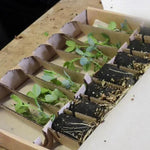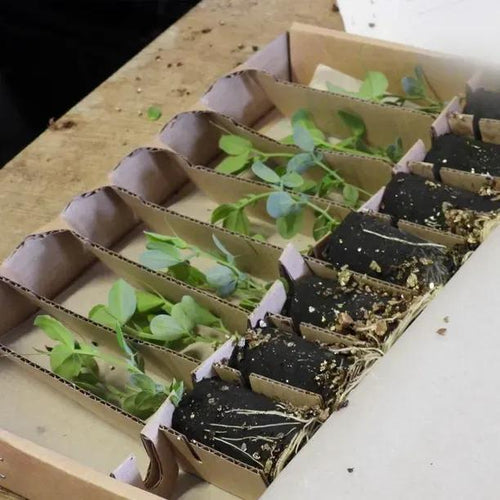Jilly Sweet Pea Plants
The blushing bride of the sweet pea world! Jilly is a demure shade of ivory, opening from lime green buds to the freshest, purest cream scented flowers, which stand out prettily against the lush green stems. She's popular in wedding bouquets, obviously, and with anyone growing sweet peas to cut and bring in for posies in vases around the house, as the stems are strong and the scent is knockout. In fact, she's an award-winning sweet pea, popular with show growers as well as the average gardener. Take a look at the others in our sweet pea range.
Our Sweet Peas are delivered in purpose-designed, recycled cardboard packaging, and are ready to be planted out when you get them.
We generally send them out between March and May, but we will email you with the likely delivery timescale once you have placed your order.
Of course, sweet peas are one of the English garden's quintessential flowers, scrambling prettily up trellis, obelisks or cane wigwams to create a haven of colour and scent, with minimal skill and attention. If you only have room for a couple of varieties, make one of them a white one, like Jilly, as she'll complement and lift any other colour, so you'll always have the perfect partner outdoors and in a vase.
Features
- Colour: Pure ivory
- Stem: long
- Height: 2.2m
- Type: Spencer
- Scent: strong and heady
- Flowering: May to October
- Planting Months: March-June
- RHS Award of Garden Merit
Growing
You can never have too many sweet peas. That's a scientific fact. So grow Jilly in a sunny border with more sweet pea varieties that will partner her well both outside and in vases indoors. Being such a fresh shade of ivory white (but not wishing in any way to sully her name), she will go with pretty much anything. That said, a deep maroon such as Black Knight makes a lasting character contrast, as does rich purple Lord Nelson. Whatever you grow her with, make sure she has support in the form of an obelisk or canes, and take a little time in spring to guide the young tendrils towards their supports – after that, she'll romp away. Combine with a summer honeysuckle – claret-tipped Lonicera belgica is a great choice – and you'll set up a pretty scented partnership that is pure romance.
One thing they can't do without is plenty of water, so give them a regular soaking with the hose in hot weather.

 Secure, One-Tap Checkout
Secure, One-Tap Checkout
 Hand Picked, Delivered to Your Door!
Hand Picked, Delivered to Your Door! 1 Year Bareroot Guarantee
1 Year Bareroot Guarantee




